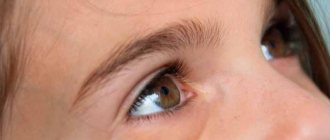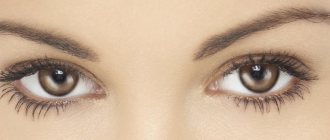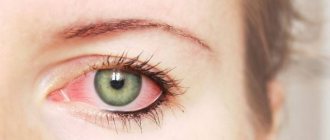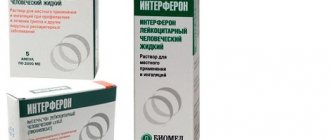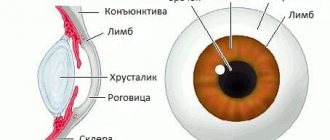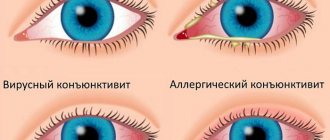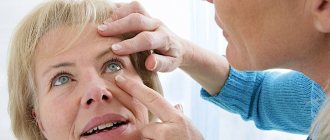Swelling of the eyelids after sleep is a fairly common occurrence. The reasons for it may be different. If they are not associated with pathological processes, swelling subsides during the day. However, it can also be a symptom of a disease. In such cases, swelling appears every morning and almost never goes away. Let's find out when you should definitely see a doctor.
In this article
- Causes of eyelid swelling
- Causes of eyelid swelling in the morning
- Swelling of the upper eyelids in the morning
- Diseases of internal organs and swelling of the upper eyelids in the morning
- Swelling in the morning due to ophthalmic diseases
- Swelling of the eyelids due to conjunctivitis
- Blepharitis and swelling of the upper eyelids
- Styes and swelling of the eyelids in the morning
- Causes of swelling of the lower eyelids
- Prevention of eyelid swelling
Causes of eyelid swelling
Edema is an excessive accumulation of fluid in organs and in the intercellular tissue space. This is the main cause of any swelling that may occur on the hands, feet, eyelids, and under the eyes. As for the factors that can provoke the accumulation of excess moisture in tissues, there are a lot of them.
The skin of the face and eyelids is the thinnest and most elastic. It stretches and swells even with a slight increase in the extracellular fluid space. If it becomes ⅓ more than the total volume, swelling occurs. On the face and eyelids, mainly the upper ones, they are especially noticeable.
The development of edema does not always indicate the presence of a pathological process in the body. Very often they go away on their own within one or two days. This means that they are not associated with pathologies of the eyes and internal organs. If the eyelids swell almost every day, swelling appears on the face every morning after sleep, then it is recommended to undergo an examination, since this symptom is observed in various diseases, including quite serious ones.
Ways to get rid of puffy eyes in the morning
It has already been noted that treatment of edema in the morning is possible only after establishing the cause of its occurrence. If this is not associated with serious pathologies, then the following measures can be taken:
- face masks;
- lotions and compresses;
- healing baths;
- massage.
All these methods are quite suitable for use at home.
Getting rid of swelling with masks
Carrying out such procedures is practically no different from those for the whole face. According to reviews, the following masks effectively cope with swelling of the eyelids:
- From fresh strawberries. Chop or cut the berries in half and apply to swollen eyelids. Leave for at least 15 minutes, but keep in mind that you may be allergic to strawberries.
- Parsley has the same positive effect. The greens must be chopped and combined with a small amount of sour cream. Cover the area around the eyes for 10-15 minutes. The swelling goes away in 30-40 minutes.
- At the pharmacy you can buy white clay, which is used for masks because it has an excellent effect on the condition of the skin. A positive effect has been noted when used to get rid of swelling of the eyelids.
When using products to prepare masks, it is important to make sure that they are safe in terms of allergic reactions. Such procedures will not only relieve swelling of the eyes, but will also have a positive effect on the condition of the facial skin.
Before using natural remedies, do a test on a small area of the skin on your hands.
Lotions and compresses for puffiness under the eyes
Compresses and contrast lotions are no less effective for swelling of the eyelids. Black or green tea or chamomile are suitable for the procedure. The brew contains tannins, which reduce the intensity of swelling, and caffeine, which constricts blood vessels. After a couple of procedures, eye swelling will no longer look so bad.
Chamomile is famous for its soothing properties; it is gentle on the skin, eliminating redness and swelling. To make a compress, soak napkins or cotton pads in the composition and apply to problem areas.
Vitamin E soothes and eliminates irritation. Add a few drops of the product to a small amount of water, dip cotton pads and apply to swollen eyelids for 15-20 minutes. The compress can also serve to prevent the appearance of edema, as it softens, moisturizes and supplies the skin around the eyes with nutrients.
Contrast lotions will have an equally effective effect. Alternately apply napkins to one eyelid and the other, soaked in warm and then cool water. This is an excellent workout for blood vessels and skin. The tone increases, metabolic processes improve. Sometimes you can even use ice cubes to instantly transform your appearance and add expressiveness to your look.
Anti-swelling massage
You can combat swollen eyelids with massage. This method of alternative medicine not only helps to get rid of puffy eyes, but also improves their health. The procedure involves the following steps:
- Wet your fingers with essential oil, but use it diluted, drop a few drops into water. If you have problems with blood pressure, then it is better to abandon this method.
- Making light, circular movements, rubbing the swollen eyelids, directing the movements towards the ears.
- The duration of the procedure is 5-10 minutes.
Instead of fingers, you can use ice cubes and do the same movements, from the eyes to the cheekbones, as if you are trying to squeeze out the swelling downwards. The effectiveness of the massage will increase if you freeze water and add a decoction of chamomile, green tea or parsley. This helps eliminate swelling in the morning and removes redness on the skin, incl. pimples and blackheads.
The procedure should not end with complete frostbite of the face; at best, you can end up with a runny nose. The skin should cool down.
Additionally, women are recommended to conduct daily facial gymnastics classes. This will remove puffiness and black circles under the eyes, as well as eliminate facial wrinkles and tighten the contour of the face.
Causes of eyelid swelling in the morning
In case of an allergic reaction, symptoms may appear within 1-2 hours. Thus, with seasonal allergic conjunctivitis, itching, burning, lacrimation and swelling of the eyelid are observed almost immediately after exposure to the allergen on the conjunctiva. Symptoms of bruises, penetrating wounds, and eyelid burns also quickly develop.
With ophthalmological diseases and pathologies of internal organs, swelling of the eyelids usually occurs in the morning. They may subside partially, but not completely, throughout the day. Also, morning swelling of the eyelids is characteristic of conditions that are not pathological. Let's take a closer look at the main causes of eyelid swelling that occurs after sleep.
Causes
There are 3 reasons (pathogenetic factors) why not only the eyelids swell, but also edema in general. These include:
- a rise in pressure in capillaries - the smallest representatives of the circulatory system;
- a drop in the amount of the protein fraction (a special role is given to albumin) and oncotic pressure in the blood plasma, with the simultaneous release of water from the bloodstream into nearby cells and tissues.
- an increase in capillary permeability, which is observed due to toxic damage to blood vessels, the presence of an inflammatory process, and disruption of regulatory mechanisms on the part of the nervous system.
The reason for such manifestations lies in the specific response of the body or the presence of a number of diseases and pathological conditions. The development of previous processes can be triggered by:
- a number of infectious diseases: conjunctivitis, inflammation of the iris, erysipelas, the presence of phlegmon, blepharitis or abscess in the eyelid, barley caused by staphylococcus, dermatitis, etc.;
- viral diseases: influenza, ARVI, etc.;
- allergic reactions, especially angioedema;
- the presence of neoplasms (both benign and malignant), for example, cholazion, cancer, etc.;
- metabolic disorders - hypothyroidism, diabetes, etc.;
- influence of parasites: demodicosis due to ciliated mites, the presence of Trichinella, etc.;
- complications of a number of diseases (usually cardiovascular, kidney and/or liver): ascites, anasarca;
- insufficient amount of protein in the body, lack of sleep, stress, chronic eye fatigue;
- poor diet (eating at night, drinking large amounts of salt or liquids;
- alcohol and tobacco abuse;
- sleeping in an uncomfortable position;
- hormonal imbalance (often observed with PMS);
- disturbances of blood flow and lymph flow;
- abnormalities in the structure of the eyelids;
- injuries and insect bites;
- taking certain medications (salicylates, sulfonamides, antibiotics).
Important! Swelling of the eyelid is observed after tattooing. This is due to tissue injury during the injection and the introduction of pigment (paint) into them. In response to injury, a nonspecific protective reaction develops, which only intensifies under the influence of pigment components. In addition, the presence of paint blocks the outflow of blood and lymph and often causes inflammation, which is why the swelling may not go away for a long time or may increase.
Useful: My lip is swollen, how to quickly remove the swelling?
Swelling of the upper eyelids in the morning
First, let's look at the causes of swelling of the upper eyelids, since the lower ones swell less often. Non-pathological factors include:
- addiction to salty, spicy or fatty foods;
- a sharp change in the food system;
- eating late in the evening or at night;
- smoking;
- taking a hot shower before bed;
- alcohol consumption;
- chronic lack of sleep;
- incorrect posture while sleeping.
Swelling of the eyelids in the morning, which occurs for one of the listed reasons, goes away after a few hours. Sometimes the body needs 1-2 days to restore the balance of fluids. You just need to eat right, get enough sleep, and give up alcohol and smoking. You can slightly reduce swelling with a cold compress.
Puffiness of the eyes not associated with pathology
What are the causes of swelling in the morning? A tumor in the lower or upper eyelid becomes noticeable due to the particularly thin layer of skin in this area.
The following are the causes of eye swelling in the morning, which are not associated with pathological processes in the body:
- Lack of sleep. Lack of rest always affects human health. It also causes swelling of the eyes in the morning. To prevent this phenomenon, wakefulness and sleep patterns should be normalized.
- Excessive fluid intake. Often, swelling of the eyes in the morning is caused by drinking large quantities of alcoholic beverages, tea or coffee before bed. To eliminate this phenomenon, you will need to avoid excessive drinking.
- Tears. What causes swelling of the eyelids in the morning? They can appear in cases where a person had to cry before going to bed. The tear fluid contains a large amount of salt, which is why it retains fluid. In addition, salt has an irritating effect on the skin, which contributes to swelling and slight inflammation in the eye area.
- Violation of the rules for the use of cosmetics. A woman who forgets to remove mascara or eye shadow at night may wake up in the morning with puffy eyes. This happens due to the skin's inability to breathe. You need to cleanse your face of makeup every day, using a special makeup remover.
- Eating excessively salty foods. Such food causes thirst, which can be quenched by drinking plenty of water. But salt that enters the body retains fluid in it. This causes swelling of the eyelids.
- Age. Over the years, it becomes increasingly difficult for the skin to maintain fiber and fatty tissue. At the same time, water metabolism in the body deteriorates due to poor kidney function. The result of such changes is swelling of the eyes in the morning.
- Hereditary predisposition. With congenital excess fat in the eye area, the eyelids appear swollen from a very early age.
- Tired eyes. The blood supply to the eyelids may deteriorate when reading in poor lighting or when sitting in front of a computer for a long time. In this case, the eyes swell due to their tension, which provokes the transition of intracellular fluid into the eyelid tissue.
- Changes in hormonal levels. Why do my eyes swell in the morning? This sometimes happens at the onset of menstruation, due to the ability of the hormone estrogen produced in large quantities to retain fluid in the body.
Diseases of internal organs and swelling of the upper eyelids in the morning
There may be more serious causes of swelling of the upper eyelids. They are associated with pathologies of internal organs. In such cases, swelling is a symptom that is usually accompanied by other signs. Swelling of the upper eyelids occurs with diseases of the liver, kidneys, cardiovascular and endocrine systems. Also observed with:
- increased blood or intracranial pressure;
- skin diseases;
- pathologies of the respiratory system;
- viral infections - influenza, ARVI, etc.
Swelling of the upper eyelids that occurs for these reasons (except infections) can be chronic. The person looks tired and sick. Swelling is observed not only on the upper eyelids, but also under the eyes. Symptoms such as headache, dizziness, loss of appetite, and increased body temperature also appear. The presence of one or two of these signs, which are often disturbing, indicates the need to undergo a detailed examination.
Now we list the causes of swelling of the upper eyelids associated with eye diseases.
Treatment
Treatment for swelling of the upper, lower or both eyelids should be started based on the cause of the condition. A similar approach in medicine is called etiotropic treatment, i.e. one that directly affects the cause of the disease or pathology. For example, if edema occurs due to the presence of heart failure, it is necessary, first of all, to make efforts to eliminate it (taking Nitroglycerin, Beta-blockers, cardiac glycosides, etc.). If the swelling occurs due to excessive accumulation of fluid outside the vascular bed, it is necessary to remove it from the body or return it back to the vessels (introduction of saline or protein solutions, etc.).
When it is impossible to resort to etiotropic treatment, they resort to pathogenetic therapy (it is aimed at preventing the development of the disease), but such treatment requires a clear knowledge of the reason for which the eyelids are swollen. Unreasoned use of drugs at the stage of pathogenetic treatment can aggravate the condition and lead to the development of severe complications. For this purpose, solutions, salts, plasma are administered, blood components are transfused, etc.
The last way to get rid of eyelid swelling is symptomatic treatment. It is aimed at eliminating symptoms, and not at eliminating the root cause and does not prevent the development of the disease. This treatment is most common among the population. But a symptomatic approach gives results in the short term. According to symptomatic therapy, to eliminate edema, you can resort to taking diuretics (use loop diuretics with caution - Furosemide, Torasemide, which quickly remove fluid and minerals dissolved in it). Lymphatic drainage massage of the body, facial and lymph node massage are also effective.
If swelling in the lower and/or upper eyelids occurs intermittently, rarely, after taking certain foods or alcohol, you should know that such a reaction is natural for the body. The same applies to the formation of edema due to stress, lack of sleep, and sleeping in an uncomfortable position. To eliminate edema formed for these reasons, it is enough to eliminate the factor causing the swelling: do not eat spicy food before bed, sleep in a comfortable position, etc.
Attention! Only a doctor knows for sure how to safely relieve eyelid swelling due to a particular disease; self-medication is dangerous to health.
Swelling in the morning due to ophthalmic diseases
Swelling of the upper eyelid is a common symptom characteristic of many eye diseases, especially inflammatory ones. Swelling can occur at any time of the day. But in the morning they are especially strong. Almost all symptoms intensify. During the night, more fluid accumulates in the intercellular space of the eyelids, including pathological fluid, so after sleep the swelling is more pronounced.
A symptom such as swelling of the eyelids is observed with conjunctivitis, blepharitis, barley, chalazion, dacryocystitis. Also, the eyes and eyelids swell with severe keratitis, uveitis and various inflammatory diseases that affect the internal structures of the eyeball.
The symptoms of ophthalmic diseases with inflammation are similar. There is no need to treat them yourself. Most of these pathologies can become chronic if treated incorrectly. This will subsequently affect your vision.
Mechanism of edema
The process of development of edema of the lower and/or upper eyelid does not differ from that with damage to other organs - edema is a characteristic reaction or pathological condition that develops according to the same mechanism, but for different reasons. In this case, edematous fluid, along with lymph, is formed from the blood. The process of edema formation starts when there is a pronounced release of the liquid part of the blood (water and substances dissolved in it) from the bloodstream.
However, normally the development of edema is prevented by a clear mechanism for maintaining water balance. It is associated with the retention of sodium (the main ion that regulates the balance of fluids in plasma and intercellular fluids) by the kidneys. ¾ of sodium in the body is constantly subject to mutual exchange with intravascular and extracellular fluid. With an increase in the amount of this mineral in extracellular fluids, the flow of water into it increases significantly. At the same time, thirst is felt. This increases the need for water intake. The condition is accompanied by the release of a specific hormone - antidiuretic hormone (ADH), which delays the release of water through the kidneys.
An imbalance of sodium ions in the extracellular and intravascular fluid is observed in chronic heart failure, when blood flow is weakened or slowed down, liver cirrhosis, hormonal imbalances, the presence of nephrotic syndrome or protein deficiency. The condition is accompanied by an increase in osmotic pressure outside the cells, which leads to increased absorption of water in the kidneys - its accumulation. Also, increased release of a specific hormone called aldosterone into the blood leads to the accumulation of water. With its excess, the absorption of sodium in the kidneys sharply increases, the volume of blood in the bloodstream decreases, and the amount of blood distilled by the heart per unit of time decreases. Excess aldosterone leads to excess hydrostatic fluid pressure outside the cells.
Mechanism of edema development
At the same time, there is an increase in the release of another hormone (vasopressin), which is responsible for the absorption of water in the kidneys. The combination of the effects of the above hormones, an increase in intravascular pressure, impaired blood flow, a decrease in the level of proteins in the blood plasma and impaired permeability of the vascular wall (which is specific to any inflammatory process) leads to the formation of edema, including edema of the eyelids.
Swelling of the eyelids due to conjunctivitis
With conjunctivitis, the conjunctiva and upper eyelid swell. They also turn noticeably red. The patient is bothered by itching, burning, and in some cases, painful sensations. The causes of this inflammatory disease determine the nature of its course and the method of treatment. Thus, with film conjunctivitis, grayish films form on the connective membrane of the eye. Because of them, vision deteriorates. They can lead to scar formation. When a bacterial infection occurs, a large amount of pus is released. During an allergic reaction, the eyelids become very itchy. Itching can only be relieved with the help of medications.
Infectious conjunctivitis usually affects the upper eyelids. Swelling of the lower ones occurs, for example, due to an allergic reaction. The extent of inflammation depends on the form of its course and treatment. If it is prescribed on time, that is, after the first signs of the disease appear, conjunctivitis does not cause complications.
Main reasons
What causes swelling in the morning? The main reasons for this are:
- Improper drinking regime. The causes of swelling in the morning lie not only in excessive water consumption. Sometimes this phenomenon is caused by a lack of fluid. Based on accepted standards, each person needs to consume at least 60 ml of water per kilogram of weight. It is this amount that contributes to the stability of the water-salt balance in the blood. If it is disrupted, fluid will be retained in the vascular bed.
- Excessive salt intake. This product, if present in large quantities in dishes, also contributes to the accumulation of fluid in the intercellular space.
- Frequent stress. Constant worry and anxiety, lack of normal rest are also important factors that cause swelling. This happens due to the production of steroid hormones by the adrenal glands. As a result, the body stops secreting the required amount of fluid.
- Alcohol. Alcohol can also dehydrate the body. Along with the liquid, some of the salts necessary to normalize blood pressure are also removed. This leads to the fact that water leaves the intercellular space and edema forms.
- Wrong place to sleep. Sometimes swelling in the morning occurs due to the fact that the head was too low during rest. This happens when using a very hard or too soft pillow.
- Passion for fashionable diets. Many girls, wanting to become the owners of ideal figures, do not eat cottage cheese and milk, legumes, eggs and meat. In other words, they follow a protein-free diet. However, it is worth keeping in mind that such restrictions are very dangerous for the body. And this is despite the fact that for some time the person continues to feel good. Of course, the process of losing extra pounds will be in full swing. However, this will not happen at all due to fatty tissue. A person on a protein-free diet loses muscle mass. After just a few weeks of eating this way, anemia, heart failure, excessive fatigue, and the development of edema are likely to occur.
Blepharitis and swelling of the upper eyelids
This disease is worth mentioning separately. It is characterized not only by swelling of the eyelids, but also by gluing of eyelashes in the morning. This happens due to the secretion of mucus and pus. Blepharitis develops as a result of microbes entering the excretory ducts of the eyelids. Bacteria are often the culprits of inflammation. The pathology occurs acutely, but often becomes chronic and periodically recurs. At the very beginning of the disease the patient complains of:
- severe itching;
- lacrimation;
- photophobia;
- diplopia.
Later other signs appear. Eyelid gluing can result in graying and loss of eyelashes.
Styes and swelling of the eyelids in the morning
With a stye, the eyelid can swell at any time, but people usually notice swelling in the morning. During the day it does not go away, and one eye is noticeably different from the other. Swelling occurs due to bacteria entering the excretory ducts of the meibomian glands or ciliary follicles. Some people mistakenly assume that stye appears due to hypothermia. But it is only a catalyst. The real cause of swelling is a bacterial infection.
Barley is accompanied by the following symptoms:
- itching and pain in the area of the affected eyelid;
- closure of the palpebral fissure, blepharospasm;
- profuse lacrimation;
- sensation of the presence of a foreign body in the eye.
Gradually the abscess grows. Sometimes the upper and lower eyelids completely close. It is possible to open the eye only with the help of hands. In such cases, surgery is performed. Often, barley opens spontaneously. But you definitely need to see a doctor. He will prescribe antibacterial drops. Antibiotics may also be required.
Severe swelling of the eyelid can also occur with chalazion, dacryocystitis and other inflammatory ailments. These are the main causes of the symptom. Now we’ll find out why the lower eyelids swell in the morning.
Quick ways to relieve swelling
There are several effective ways to quickly remove swelling from the eyelids. Basically, they are symptomatic treatment. Among them are methods recognized by official medicine (massage on a problem organ, taking diuretics), cosmetic products, and recipes from traditional medicine. We present the most popular and simple ways to quickly eliminate swelling on the eyelids.
Taking diuretics
Diuretic medications can give swollen eyelids a natural look in the next half hour. The fastest-acting drugs are those of the loop diuretic group, the effect of which, when administered in solutions, occurs within 5-10 minutes. However, using them more than once is not recommended due to the pronounced effect and side effects. Thiazide drugs act more slowly, but their use is not recommended for swelling of the eyelids due to their powerful effect and a number of side effects. It would be optimal to take potassium-sparing drugs (Veroshpiron, Spironolactone, etc.), which, although they act the slowest, have a mild effect and are free from the side effects of previous drugs.
Lymphatic drainage complex
The action of the complex is based on a mechanical effect on lymphatic vessels and nodes. Along the lymphatic pathways, a pressure gradient is artificially created, which makes it possible to increase the speed of lymph flow, “push” lymph through the vessels, eliminate its stagnation, and remove fluid from tissues. If the upper and/or lower eyelid is swollen, 1 session is sufficient. Note that the movements begin from the inner corner of the eye outward, moving along the eyelid itself.
Traditional methods
Treatment with tea compresses. An effective method that has been proven over the years. The action is based on the tonic effect of tea leaves on the skin and blood vessels. In order to make a compress, you need:
- Brew a couple of tea bags.
- Allow the drink to cool.
- Soak several cotton swabs in tea.
- Apply tampons to problem areas for 15-20 minutes.
- Remove the compress, wipe your eyelids or wash with warm water and soap.
Compresses with milk or chicken egg whites. You need to prepare 2-4 cotton swabs or sponges, moisten them in warm (preferably boiled) milk and apply to the eyelids. After 20 minutes, the compress can be removed. After the procedure, you need to wash your face with warm water and soap. Similar to milk, you can use compresses with beaten egg whites. In addition to eliminating puffiness, protein will saturate the skin with essential vitamins and amino acids.
Application of creams
Cosmetic preparations that act as local decongestants will allow you to quickly relieve swelling of the eyelids. Special creams and masks are widely used. They allow you to give your eyelids a natural look in ½ - 1 hour. In addition, cosmetics nourish and tone the skin, eliminate wrinkles and vascular network, and help prevent the formation of edema.
Important! Before using this or that product, it is recommended to determine why eyelid edema may have formed. If you suspect the formation of edema due to pathology of internal organs, allergies, or injury, we advise you to seek help from a doctor.
Causes of swelling of the lower eyelids
The diseases listed earlier can lead to swelling of both the upper and lower eyelids. It’s just that the upper ones become inflamed more often. Swelling of the lower parts can also occur for other reasons, non-pathological. Some of them are natural, such as loose facial muscles. Over the years, muscles lose tone. The skin also becomes less elastic. It may sag, especially in the morning. The area under the eye becomes swollen. Bags and bruises appear. Relaxed muscles occupy more volume than tense muscles. This becomes the main cause of edema.
Also, the lower eyelids swell with the growth of subcutaneous tissue. This symptom is observed in some women over 35 years of age and is called hernia. Fiber helps normalize the temperature of the tissues surrounding it. It is also involved in metabolic processes.
When these functions are disrupted, bags under the eyes form. You can only get rid of them with the help of plastic surgery - removing excess fatty tissue and tightening the skin.
Prevention
Swelling under the eyes in the morning occurs as a result of the accumulation of a large amount of fluid in the tissues. An unsightly, unpleasant manifestation can occur anywhere: on the arms or legs, on the torso, on internal organs or on the face. The peculiarities of the processes and the composition of the accumulated liquid differ depending on the causes of formation.
Few people can boast that they have never wondered how to quickly remove puffiness under the eyes in the morning.
Especially often, everyone encounters such a nuisance after a stormy night, or vice versa, after a serious emotional shock, accompanied by tears.
To distinguish severe swelling under the eyes that occurs as a result of natural physiological processes from symptoms of serious pathologies, it is worth carefully understanding the reasons for their formation.
Causes of swelling
When studying why there is swelling under the eyes in the morning, users mean swelling of the upper or lower eyelid due to an increase in the amount of interstitial fluid. Our body consists of 60% water.
The overwhelming amount of fluid is concentrated inside the cells, and the rest is in the space between them. Water-electrolyte balance, uninterrupted operation of individual organs and systems, allows you to maintain this ratio without changes.
When the balance in the body is disturbed under the influence of any reasons or diseases, bruises and swelling appear under the eyes.
Why does it swell under the eyes in the morning, and not in another area? This is due to the anatomical properties of the tissues located in this area. Here the skin is quite thin, and the subcutaneous fatty tissues are distinguished by a rather loose constitution and the absence of sebaceous glands. In this zone, muscle activity is also quite low. It is also worth noting that bags and swelling around the eyes are two different concepts.
Bags form as a result of loss of skin elasticity. Edema causes the accumulation of intercellular fluid, which is formed as a result of an imbalance.
Serious symptoms
When your face swells in the morning and there are bags under your eyes, you should consider the possibility of a failure of internal systems. Often, excessive fluid accumulation indicates pathology in the kidney area. In this situation, the lower eyelid suffers more:
- the swelling has a watery consistency;
- a bronze tint appears;
- As a concomitant symptom, it is worth talking about rapid weight gain as a result of fluid accumulation in all organs.
In an adult or child, swelling under the eyes in the morning may appear due to a nasal infection. After removing the nasal infection, the swelling will go away without additional impact.
Pathologies of the endocrine system can cause swelling under the eyes in women and men. The cause is insufficient hormonal stimulation, leading to the accumulation of mucous formations under the skin.
Cardiovascular disorders lead to the formation of swelling in the evening. Some attribute this to general fatigue. However, if the phenomenon is constantly repeated, it is worth considering the need to visit a specialist.
Lifestyle
When considering dark puffiness under the eyes, you don't always need to rush to the doctor. In some situations, it is enough to reconsider your lifestyle. Among the bouquet of reasons provoking such phenomena, the leading ones are:
- alcohol (drug) consumption;
- heavy consumption of carbonated drinks with sugar;
- short sleep that does not bring rest;
- bright lighting that blinds the eyes.
When looking at how to get rid of puffy eyes in such situations, apply the following measures:
- control of daily diet;
- walk, airing the bedroom before bedtime;
- sufficient physical activity;
- complete rest.
In addition to the above recommendations, professionals advise maintaining a drinking regime, consuming at least 1.5 liters of water daily. If there is edema, 65% of the liquid should be drunk before 14-00. Moreover, you cannot replace it with drinks or sweet soda. If there is not enough clean, non-carbonated water, the body begins to store it.
Dangerous cosmetics
When starting treatment for morning puffiness under the eyes, pay attention to cosmetics that can provoke such phenomena. The use of cosmetics in itself should not lead to a negative reaction. In such aspects, the culture of their application is of greater importance. To avoid swelling, you should follow simple rules:
- Carefully remove any products applied in the morning. At the same time, the cleansing ritual should not be postponed until bedtime. The skin should breathe a little after washing.
- To remove persistent cosmetics, use special products. Don't get carried away with toilet soap. This leads to negative consequences.
- Read carefully and study the composition and effect of the night cream. When a film forms as a result of its use, swelling may appear in the eye area in the morning.
One of the most important rules in the fight against puffiness is moderation in everything. By generously applying decorative cosmetics in the eye area and removing it poorly in the evening, you can get irritation, allergies, and other troubles.
Practice shows that the treatment of swelling under the eyes, which is not a symptom of a serious disease, is quite easy. You can get your face into proper shape without the help of specialists, at home. For this purpose, no major material investments are required. Simple procedures will not take much time or require much effort.
Among the options that help find a solution to how to remove puffiness under the eyes, experts recommend:
- creams, ointments;
- compresses, baths;
- massages.
Having tried several methods from the options proposed below, you can easily choose the optimal solution for yourself or you can combine procedures, depending on your desire and mood.
Modern cosmetology has a number of answers to the question of how to remove puffiness under the eyes after sleep. Innovative products offered by manufacturers allow you to temporarily get rid of external manifestations, but cannot eliminate the cause of unsightly phenomena. Among the effective cosmetic procedures it is worth noting:
- Cryolifting is a unique procedure that allows you to create tension in tissue cells, activate metabolic processes, and remove excess moisture.
- Mesotherapy is an innovative injection technique that involves introducing small doses of amino acids and vitamin preparations into problem areas.
As a result of the procedures, a long-lasting cosmetic effect is observed, but not treatment. In addition to visiting specialists, there is the opportunity to take care of your beauty yourself.
When choosing a cream for puffy eyes, pay attention to natural products based on medicinal plants.
Such preparations contain a minimum of chemical elements and are not capable of causing allergies.
Baths, compresses
A compress with tea will help relieve swelling immediately after sleep. It doesn’t matter which one you choose, black or green, both options contain tannin and caffeine. The first has an astringent ability, so it can reduce the level of swelling. The latter will reduce swelling due to vasoconstriction.
Chamomile tea is a unique and affordable remedy. In addition to the above capabilities, it has an anti-inflammatory effect, further reducing swelling and redness.
As a bath, you can use a solution of a few drops of vitamin E in water. Wet cotton pads and lie with them on your eyes for about 20 minutes. This procedure has not only an anti-edematous, but also a powerful cosmetic effect. The skin around the eyes is very sensitive. Vitamin compresses will qualitatively moisturize it, nourish it, smooth it, and remove unwanted swelling.
Massage
Massage against swelling under the eyes has an equally powerful cosmetological effect. The swollen areas are rubbed with light circular movements, heading towards the ears. This reduces the negative effect after sleep, and also affects the bioactive points responsible for eye health.
To make the massage softer and less traumatic, it is recommended to use ointment for swelling under the eyes and moisten the edges of your fingers with essential oil. The latter cannot be used in its pure form, as it can cause serious irritation. Add a couple of drops of cosmetic oil to vegetable oil (preferably olive oil).
Ice will help enhance the effect of the massage. In the evening, freeze a decoction of parsley, tea or chamomile. Massage the swelling with cubes that have just been removed from the freezer, squeezing the liquid from the eyes to the cheeks. The procedure must be carried out carefully, fearing hypothermia. Otherwise, you will also have to deal with a runny nose.
Let's sum it up
Morning puffiness under the eyes can indicate a well-spent evening, emotional turmoil, or serious health problems. This phenomenon can be provoked by ordinary heat or spicy food eaten at dinner. Also, the cause of swelling can be seasonal allergies, which can be eliminated by taking antihistamines under the supervision of a specialist.
Preventing swelling is always easier than treating unsightly swelling. An active lifestyle combined with proper nutrition will ensure a fresh look for many years. It is also important to arrange for yourself the correct position while resting. The head should be slightly higher than the rest of the body. It is recommended to sleep on your back rather than on your stomach or side.
- To avoid problems, you need to properly treat diseases. Timely professional therapy is the key to recovery.
- You need to eat right and lead a healthy lifestyle. You can accustom yourself to hardening, morning exercises.
- It is worth giving up bad habits, including smoking, drinking alcohol, and overeating.
- You should not consume a lot of liquid. If a person drinks 2 liters. water per day, the kidneys will experience severe stress. The problem will lead not only to swelling of the eyelids and limbs, but also to diseases.
- You need to be careful when consuming vitamins and nutritional supplements. Before taking such medications, you should consult your doctor.
- You should not overuse salty foods. Salt retains water in the body: this leads to swelling.
- An important rule is to follow safety precautions in hazardous industries. If a person, due to his profession, comes into contact with gas or flammable liquid, he should wear protective glasses and masks.
Prevention of eyelid swelling
The eyelids swell for pathological and non-pathological reasons. There are quite a lot of them, so it’s difficult to talk about specific prevention. But some rules can still be formulated. They will help avoid swelling or eye diseases that can provoke them.
Recommended:
- start treating all diseases in a timely manner, get examined more often;
- maintain hygiene;
- reduce the amount of salt consumed;
- give up alcohol and smoking;
- drink as little liquid as possible before bed;
- sleep 7-8 hours a day at night;
- play sports and walk in the fresh air.
